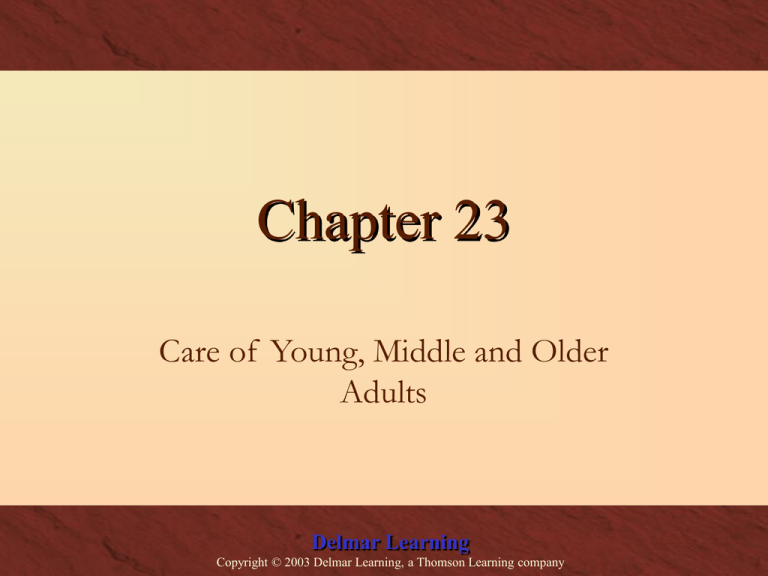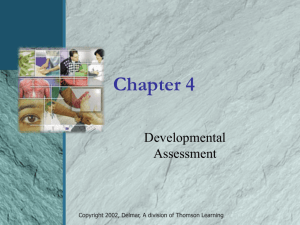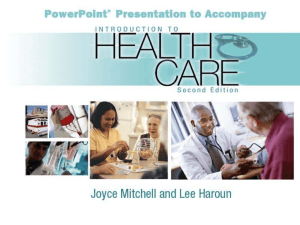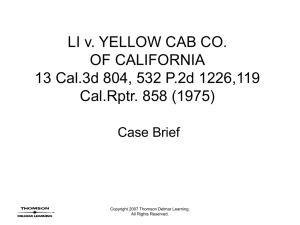Power Notes - Delmar
advertisement

Chapter 23 Care of Young, Middle and Older Adults Delmar Learning Copyright © 2003 Delmar Learning, a Thomson Learning company Theories of Growth and Development • Young Adult • Middle Adult • Older Adult Chapter 23 20 – 40 years 40 – 65 years 65 years to death Copyright © 2003 Delmar Learning, a Thomson Learning company Levinson’s Developmental Stages of Adulthood • • • • • Early adult transition Entrance into adult world Transition Settling down Pay-off years Chapter 23 Copyright © 2003 Delmar Learning, a Thomson Learning company Erikson’s Stages of Psychosocial Development • Intimacy vs. Isolation • Generativity vs. Stagnation • Integrity vs. Despair Chapter 23 Copyright © 2003 Delmar Learning, a Thomson Learning company Young Adult Risk Factors • • • • • • Substance abuse Suicide Sexuality Sexually transmitted diseases Violence Accidents Chapter 23 Copyright © 2003 Delmar Learning, a Thomson Learning company Middle Adult • • • • Characterized by stability Physical development Cognitive development Psychosocial development Chapter 23 Copyright © 2003 Delmar Learning, a Thomson Learning company Middle Adult Risk Factors • • • • • Midlife crisis Generation gap Sandwich generation Emergence of chronic health problems Financial concerns Chapter 23 Copyright © 2003 Delmar Learning, a Thomson Learning company Older Adult • • • • • Physical development Systemic changes Sexuality Sensory changes Cognitive development Chapter 23 Copyright © 2003 Delmar Learning, a Thomson Learning company Older Adult Development • Psychosocial development Ego integrity vs. despair • Retirement and life review • Facing death Chapter 23 Copyright © 2003 Delmar Learning, a Thomson Learning company Older Adult Risk Factors • • • • Depression Loss Social support Dementia Chapter 23 Copyright © 2003 Delmar Learning, a Thomson Learning company Older Adult Risk Factors (cont.) • • • • Sensory impairment Cancer Ageism Bereavement Chapter 23 Copyright © 2003 Delmar Learning, a Thomson Learning company Guidelines for Helping Persons Who Are Blind • • • • • Use a normal tone of voice. Give explicit directions. Use a clock to describe food placement. Announce the presence of other guests. Communicate when you enter and leave the room. Chapter 23 Copyright © 2003 Delmar Learning, a Thomson Learning company Guidelines for Communicating with Persons Who are Hearing Impaired • • • • • Speak distinctly but naturally. Face the person as you speak to him. Speak to the “good” ear. Use facial expressions to convey meaning. Obtain the person’s attention before speaking. Chapter 23 Copyright © 2003 Delmar Learning, a Thomson Learning company Safety • Risk factors Sensory impairment Physical disability Cognitive impairment Chapter 23 Copyright © 2003 Delmar Learning, a Thomson Learning company Fall Prevention • Fall Prevention Interventions to decrease fall risk • • • • Reduce environmental hazards Improve home supports Medication modification Caregiver education Chapter 23 Copyright © 2003 Delmar Learning, a Thomson Learning company Implications for Community Nursing Practice • Primary prevention • Secondary prevention • Tertiary prevention Chapter 23 Copyright © 2003 Delmar Learning, a Thomson Learning company Tips for Aging Successfully • Inner aspect of aging Relationship to self • Outer aspect of aging Relationship to community Chapter 23 Copyright © 2003 Delmar Learning, a Thomson Learning company Fostering Health Relationships • Caring family support system • Intergenerational involvement • Integration of multiple support systems Chapter 23 Copyright © 2003 Delmar Learning, a Thomson Learning company







